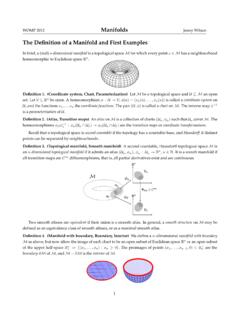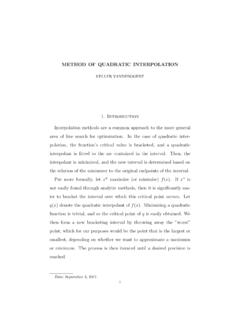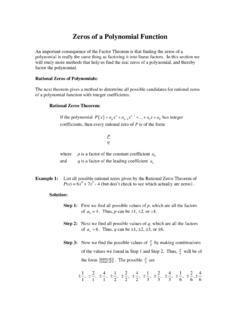The Remainder Theorem
Found 10 free book(s)The Chinese Remainder Theorem - luc.edu
gauss.math.luc.eduBy solving this by the Chinese remainder theorem, we also solve the original system. (The solution is x 20 (mod 56).) Of course, the formula in the proof of the Chinese remainder theorem is not the only way to solve such problems; the technique presented at the beginning of this lecture is actually more general, and it requires no mem-orization.
The Chinese Remainder Theorem - homepages.math.uic.edu
homepages.math.uic.eduChinese Remainder Theorem tells us that there is a unique solution modulo m, where m = 11 ⋅ 16 ⋅ 21 ⋅ 25 = 92400. We apply the technique of the Chinese Remainder Theorem with k = 4, m 1 = 11, m 2 = 16, m 3 = 21, m 4 = 25, a 1 = 6, a 2 = 13, a 3 = 9, a 4 = 19, to obtain the solution. We compute z 1 = m / m 1 = m 2 m 3 m 4 = 16 ⋅ 21 ⋅ ...
The Remainder Theorem - cdn.kutasoftware.com
cdn.kutasoftware.comThe Remainder Theorem Date_____ Period____ Evaluate each function at the given value. 1) f (x) = −x3 + 6x − 7 at x = 2 2) f (x) = x3 + x2 − 5x − 6 at x = 2 3) f (a) = a3 + 3a2 + 2a + 8 at a = −3 4) f (a) = a3 + 5a2 + 10 a + 12 at a = −2 5) f (a) = a4 + 3a3 − 17 a2 + 2a − 7 at a = 3 6) f (x) = x5 − 47 x3 − 16 x2 + 8x + 52 at ...
1 Factoring Formulas - Department of Mathematics
math.colorado.eduTheorem 8.4 (Remainder Theorem) If a real polynomial p(x) is divided by (x c) with the result that p(x) = (x c)q(x) + r (r is a number, i.e. a degree 0 polynomial, by the division algorithm mentioned above), then r = p(c) 9 Exponential and Logarithmic Functions
CALCULUS I - hi
notendur.hi.isequations in the remainder will need a calculator. Review : Solving Trig Equations with Calculators, Part II – Even more trig ... The Mean Value Theorem – Here we will take a look that the Mean Value Theorem. Optimization Problems – …
The Definition of a Manifold and First Examples
www.math.lsa.umich.eduwhere the remainder R (x) = j j ! Z 1 0 (1 t)j j 1D f y+t(x y) dt Tangent Spaces and Derivatives Definition 9.(Tangent Space T xM, Derivatives) Suppose that Mis a smooth m-dimensional submanifold of some Euclidean space RN. (We will see in Theorem 18 that every manifold can be realized this way). Let ˚: U!
METHOD OF QUADRATIC INTERPOLATION
people.math.sc.eduThis remainder term will often be denoted R n+1. Theorem 3.3. Let f: R !R be 3 times continuously di erentiable. Let x* be such that f0(x) = 0 and f00(x) 6= 0 . Then the sequence fx ng generated by (2.7) converges to x with order 1+ p 5 2. Proof. We rst want to prove that (2.7) does indeed converge to our minimizer, x.
Zeros of a Polynomial Function - Alamo Colleges District
www.alamo.eduTheorem. 2. Divide: Use Synthetic division to evaluate the polynomial at each of the candidates for rational zeros that you found in Step 1. When the remainder is 0, note the quotient you have obtained. 3. Repeat: Repeat Steps 1 and 2 for the quotient. Stop when you reach a quotient that is quadratic or factors easily, and use the quadratic formula
Remainder Theorem and Factor Theorem - mrsk.ca
mrsk.caRemainder Theorem and Factor Theorem Remainder Theorem: When a polynomial f (x) is divided by x − a, the remainder is f (a)1. Find the remainder when 2x3+3x2 −17 x −30 is divided by each of the following: (a) x −1 (b) x − 2 (c) x −3 (d) x +1 (e) x + 2 (f) x + 3 Factor Theorem: If x = a is substituted into a polynomial for x, and the remainder is 0, then x − a is a factor of the ...
Chapter 11 Subgame-Perfect Nash Equilibrium
ocw.mit.eduTheorem 11.1 (Single-deviation Principle) In a multistage game that is continu ous at infinity, a strategy profile is a subgame-perfect Nash equilibrium if and only if it passes the single-deviation test at every stage for every player.









